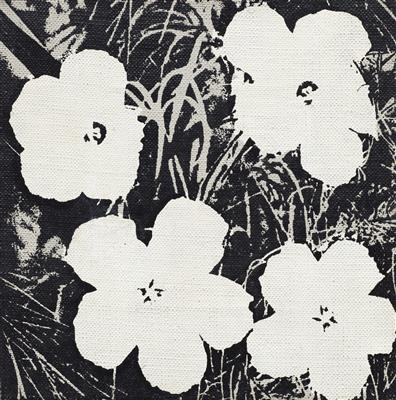Andy Warhol

(Pittsburgh 1928–1987 New York)
Flowers, 1964, monogrammed, dated on the overlap A. W. 64, acrylic, silkscreen on canvas, 5 in x 5 in (12.7 x 12.7 cm), framed
Provenance:
Private Collection, USA
The Major Gallery London (gallery label on the reverse)
Galerie Burkhard Eikelmann, Düsseldorf
Private Collection, Germany - acquired from the above
“Don’t think about making art, just get it done.
Let everyone else decide if it’s good or bad, whether they love it or hate it. While they are deciding, make even more art.”
Andy Warhol
With his pioneering silkscreens of Campbell’s Soup Cans, the portrait of Marilyn Monroe, and his serial depictions of pop icons, Andy Warhol has been considered one of the leading artists of Pop Art since the 1960s.
When the shop window of Bonwit Teller in New York was redesigned, Andy Warhol was able to show five of his works to the general public for the first time in 1961. The pictorial content of his photographs from magazines, newspaper advertisements, and comic strips are original American metaphors of metamorphosis and self-transcendence and at the same time reflect Andy Warhol’s own yearnings. Andy Warhol takes the technique of photomechanically processed screen prints from the mass media. Originally, the screen printing method was developed for commercial use, but Andy Warhol was influenced by his work in advertising and transformed the reproduction process into his characteristic style. In doing so, he distances himself from the personal signature of the artist who paints, yet with his method of image composition he creates a new phase of image manipulation, whereby the unique character of his works remains the same as a painting.
With the Flowers series, created in 1964, Andy Warhol turns his back on his image as an artist depicting pop culture and commerce and, with the four flowers in front of tufts of grass, turns his attention to nature. In 1964, this devotion to nature was controversially discussed and was considered a surprising departure from the previous politically and often commercially influenced motifs. The representation of the Flowers is detached from time and space and for today’s viewer it fits perfectly into Warhol’s serial, colourful images. Andy Warhol did not take his motif for the Flowers directly from nature, but was inspired by a photograph of hibiscus flowers in the magazine Modern Photograph in 1964, which he alienated and backed with the tufts of grass. The silkscreen printing of the flowers comprises several blocks of colour, whilst further blocks were made for the bed of grass. Screen printing is a good way to experiment with colour and layering, and Andy Warhol played and worked with both. He used different colour schemes and the flowers in one print are designed in bright pink and orange and in the next he reduced the colouring of the flowers to bright white, with a black and white bed of grass in the background. In some prints he deviates from the original template and creates the shadows of multiple flowers through several screen prints. Playful and inviting without being obtrusive, Flowers was first exhibited at the Leo Castelli Gallery in New York in 1964.
The tension between the naivety of the flowers and the mechanical art, makes this series still fascinating today. On the one hand, the flowers that Warhol selected for this series are impersonal. Their source is a photograph for which no import was ever identified. On the other hand, the prints encourage the viewer to consider the playfulness of flowers in relation to their own simplicity, even if they cannot be identified. The small black and white flowers show us a very uncomplicated view of the garden through the lens of Andy Warhol, making his motivation and concept all the more apparent to us. The Flowers are simple but bold, lively yet assignable, small but room-filling. And it is precisely these characteristics that still make them so special to this very day.
Esperta: Dr. Petra Maria Schäpers
 Dr. Petra Maria Schäpers
Dr. Petra Maria Schäpers
petra.schaepers@dorotheum.de
24.06.2020 - 16:00
- Prezzo realizzato: **
-
EUR 222.900,-
- Stima:
-
EUR 140.000,- a EUR 180.000,-
Andy Warhol
(Pittsburgh 1928–1987 New York)
Flowers, 1964, monogrammed, dated on the overlap A. W. 64, acrylic, silkscreen on canvas, 5 in x 5 in (12.7 x 12.7 cm), framed
Provenance:
Private Collection, USA
The Major Gallery London (gallery label on the reverse)
Galerie Burkhard Eikelmann, Düsseldorf
Private Collection, Germany - acquired from the above
“Don’t think about making art, just get it done.
Let everyone else decide if it’s good or bad, whether they love it or hate it. While they are deciding, make even more art.”
Andy Warhol
With his pioneering silkscreens of Campbell’s Soup Cans, the portrait of Marilyn Monroe, and his serial depictions of pop icons, Andy Warhol has been considered one of the leading artists of Pop Art since the 1960s.
When the shop window of Bonwit Teller in New York was redesigned, Andy Warhol was able to show five of his works to the general public for the first time in 1961. The pictorial content of his photographs from magazines, newspaper advertisements, and comic strips are original American metaphors of metamorphosis and self-transcendence and at the same time reflect Andy Warhol’s own yearnings. Andy Warhol takes the technique of photomechanically processed screen prints from the mass media. Originally, the screen printing method was developed for commercial use, but Andy Warhol was influenced by his work in advertising and transformed the reproduction process into his characteristic style. In doing so, he distances himself from the personal signature of the artist who paints, yet with his method of image composition he creates a new phase of image manipulation, whereby the unique character of his works remains the same as a painting.
With the Flowers series, created in 1964, Andy Warhol turns his back on his image as an artist depicting pop culture and commerce and, with the four flowers in front of tufts of grass, turns his attention to nature. In 1964, this devotion to nature was controversially discussed and was considered a surprising departure from the previous politically and often commercially influenced motifs. The representation of the Flowers is detached from time and space and for today’s viewer it fits perfectly into Warhol’s serial, colourful images. Andy Warhol did not take his motif for the Flowers directly from nature, but was inspired by a photograph of hibiscus flowers in the magazine Modern Photograph in 1964, which he alienated and backed with the tufts of grass. The silkscreen printing of the flowers comprises several blocks of colour, whilst further blocks were made for the bed of grass. Screen printing is a good way to experiment with colour and layering, and Andy Warhol played and worked with both. He used different colour schemes and the flowers in one print are designed in bright pink and orange and in the next he reduced the colouring of the flowers to bright white, with a black and white bed of grass in the background. In some prints he deviates from the original template and creates the shadows of multiple flowers through several screen prints. Playful and inviting without being obtrusive, Flowers was first exhibited at the Leo Castelli Gallery in New York in 1964.
The tension between the naivety of the flowers and the mechanical art, makes this series still fascinating today. On the one hand, the flowers that Warhol selected for this series are impersonal. Their source is a photograph for which no import was ever identified. On the other hand, the prints encourage the viewer to consider the playfulness of flowers in relation to their own simplicity, even if they cannot be identified. The small black and white flowers show us a very uncomplicated view of the garden through the lens of Andy Warhol, making his motivation and concept all the more apparent to us. The Flowers are simple but bold, lively yet assignable, small but room-filling. And it is precisely these characteristics that still make them so special to this very day.
Esperta: Dr. Petra Maria Schäpers
 Dr. Petra Maria Schäpers
Dr. Petra Maria Schäpers
petra.schaepers@dorotheum.de
|
Hotline dell'acquirente
lun-ven: 10.00 - 17.00
kundendienst@dorotheum.at +43 1 515 60 200 |
| Asta: | Arte contemporanea I |
| Tipo d'asta: | Asta in sala |
| Data: | 24.06.2020 - 16:00 |
| Luogo dell'asta: | Wien | Palais Dorotheum |
| Esposizione: | 18.06. - 24.06.2020 |
** Prezzo d'acquisto comprensivo di tassa di vendita e IVA
Non è più possibile effettuare un ordine di acquisto su Internet. L'asta è in preparazione o è già stata eseguita.
Altri oggetti dell'artista
-

Stima:
EUR 6.000,- a EUR 10.000,- -

Stima:
EUR 1.500,- a EUR 2.500,-
